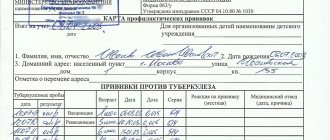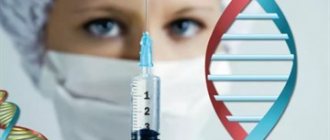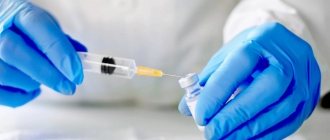Vaccines are preparations intended to create active immunity in the body of vaccinated people or animals. The main active principle of each vaccine is an immunogen, i.e. a corpuscular or dissolved substance that carries chemical structures similar to the components of the pathogen responsible for the production of immunity. Depending on the nature of the immunogen, vaccines are divided into:
- whole-microbial or whole-virion , consisting of microorganisms, respectively bacteria or viruses, which retain their integrity during the manufacturing process;
- chemical vaccines made from waste products of a microorganism (a classic example is toxoids ) or its integral components, the so-called. submicrobial or subvirion vaccines;
- genetically engineered vaccines containing expression products of individual microorganism genes produced in special cellular systems;
- chimeric, or vector vaccines , in which a gene that controls the synthesis of a protective protein is built into a harmless microorganism in the expectation that the synthesis of this protein will occur in the body of the vaccinated person and, finally;
- synthetic vaccines , where a chemical analogue of a protective protein obtained by direct chemical synthesis is used as an immunogen.
In turn, among whole-microbial (whole-virion) vaccines, inactivated, or killed , and live attenuated ones are distinguished. The effectiveness of live vaccines is ultimately determined by the ability of the attenuated microorganism to multiply in the body of the vaccinated person, reproducing the immunologically active components directly in his tissues. When using killed vaccines, the immunizing effect depends on the amount of immunogen administered as part of the drug, therefore, in order to create more complete immunogenic stimuli, it is necessary to resort to the concentration and purification of microbial cells or viral particles.
Live vaccines
Attenuated - weakened in its virulence (infectious aggressiveness), i.e. artificially modified by man or “donated” by nature, which changed their properties in natural conditions, an example of which is the vaccinia vaccine. The active factor of such vaccines is the altered genetic characteristics of microorganisms, which at the same time ensure that the child suffers a “minor disease” with the subsequent acquisition of specific anti-infectious immunity. Examples include vaccines against polio, measles, mumps, rubella or tuberculosis.
Positive aspects : according to the mechanism of action on the body, they resemble the “wild” strain, can take root in the body and maintain immunity for a long time (for measles vaccine, vaccination at 12 months and revaccination at 6 years), displacing the “wild” strain. Small doses are used for vaccination (usually a single dose) and therefore vaccination is easy to carry out organizationally. The latter allows us to recommend this type of vaccine for further use.
Negative aspects : live corpuscular vaccine - contains 99% ballast and therefore is usually quite reactogenic; in addition, it can cause mutations in body cells (chromosomal aberrations), which is especially dangerous in relation to germ cells. Live vaccines contain contaminating viruses (contaminants), this is especially dangerous in relation to simian AIDS and oncoviruses. Unfortunately, live vaccines are difficult to dose and biocontrol, are easily sensitive to high temperatures and require strict adherence to the cold chain.
Although live vaccines require special storage conditions, they produce fairly effective cellular and humoral immunity and usually require only one booster dose. Most live vaccines are administered parenterally (with the exception of polio vaccine).
Against the background of the advantages of live vaccines, there is one caveat , namely: the possibility of reversion of virulent forms, which can cause illness in the vaccinee. For this reason, live vaccines must be thoroughly tested. Patients with immunodeficiencies (receiving immunosuppressive therapy, AIDS and tumors) should not receive such vaccines.
Examples of live vaccines include vaccines for the prevention of rubella (Rudivax), measles (Ruvax), polio (Polio Sabin Vero), tuberculosis, mumps (Imovax Oreion).
Inactivated (killed) vaccines
Inactivated vaccines are produced by exposing microorganisms chemically or by heating. Such vaccines are quite stable and safe, since they cannot cause a reversion of virulence. They often do not require cold storage, which is convenient for practical use. However, these vaccines also have a number of disadvantages, in particular, they stimulate a weaker immune response and require multiple doses.
They contain either a killed whole microorganism (eg whole cell pertussis vaccine, inactivated rabies vaccine, hepatitis A vaccine) or components of the cell wall or other parts of the pathogen, such as in acellular pertussis vaccine, haemophilus influenzae conjugate vaccine or against meningococcal infection. They are killed by physical (temperature, radiation, ultraviolet light) or chemical (alcohol, formaldehyde) methods. Such vaccines are reactogenic and are rarely used (whooping cough, hepatitis A).
Inactivated vaccines are also corpuscular. When analyzing the properties of corpuscular vaccines, one should also highlight both their positive and negative qualities. Pros : Killed corpuscular vaccines are easier to dose, easier to clean, have a longer shelf life, and are less sensitive to temperature fluctuations. Negative aspects : the vaccine is corpuscular - contains 99% ballast and is therefore reactogenic; in addition, it contains an agent used to kill microbial cells (phenol). Another disadvantage of an inactivated vaccine is that the microbial strain does not take root, therefore the vaccine is weak and vaccination is carried out in 2 or 3 doses, requiring frequent revaccinations (DPT), which is more difficult to organize compared to live vaccines. Inactivated vaccines are produced both in dry (lyophilized) and liquid form. Many microorganisms that cause diseases in humans are dangerous because they secrete exotoxins, which are the main pathogenetic factors of the disease (for example, diphtheria, tetanus). Toxoids used as vaccines induce a specific immune response. To obtain vaccines, toxins are most often neutralized using formaldehyde.
Types of vaccine preparations
There are several main classifications of drugs of this type, which include:
- live vaccines . The main component of the serum is pathogens for which immunity must be developed. Such a virus does not have the opportunity to develop into a serious illness, but the body manages to develop protection. Used to prevent influenza, measles and mumps;
- inactivated . It is a corpuscular vaccination, since the composition can only contain components of the virus. In some cases, already dead bacteria are used. The drug is effective against rabies and hepatitis;
- toxoids . When making vaccinations, toxins are used, which are the result of bacterial activity.
Most often, the attending physician determines which vaccinations are necessary. Self-diagnosis without the necessary knowledge can be the main reason for accidentally contracting a dangerous disease.
Live vaccines are the most dangerous for a child. It is recommended not to use them in the first months of a baby’s life.
Chemical vaccines
Contain components of the cell wall or other parts of the pathogen, such as in acellular pertussis vaccine, Haemophilus influenzae conjugate vaccine or meningococcal vaccine.
Chemical vaccines are created from antigenic components extracted from a microbial cell. Those antigens are isolated that determine the immunogenic characteristics of the microorganism. These vaccines include: polysaccharide vaccines (Meningo A + C, Act - Hib, Pneumo 23, Typhim Vi), acellular pertussis vaccines.
When can we expect a vaccine to appear?
In the “pre-coronavirus era,” the development of one vaccine took on average more than 10 years. The only exception is the vaccine against the Ebola virus: Merck completed the development of this drug in a record five years. But in the midst of the COVID-19 pandemic, no country in the world has that much time, so government regulators and pharmaceutical companies are accelerating the development and testing of vaccine candidates - for example, the US government hopes to have a ready-made drug by early 2021.
If this really works out, it will be an unprecedented step forward for all of humanity. However, this is still not very likely. Considering all of the above, it makes no sense to wait for a vaccine against COVID-19 earlier than in 12-18 months.
By the way, a special website has recently appeared that aggregates information from the WHO, the American Centers for Disease Control and Prevention (CDC) and other sources: COVID-19 Vaccine & Therapeutics Tracker. The site is convenient for monitoring the development of vaccines in real time.
Biosynthetic vaccines
In the 1980s, a new direction was born, which is now successfully developing - the development of biosynthetic vaccines - vaccines of the future.
Biosynthetic vaccines are vaccines obtained using genetic engineering methods and are artificially created antigenic determinants of microorganisms. An example is a recombinant vaccine against viral hepatitis B, a vaccine against rotavirus infection. To obtain them, yeast cells are used in culture, into which an excised gene is inserted, encoding the production of the protein necessary to obtain the vaccine, which is then isolated in its pure form.
At the present stage of development of immunology as a fundamental medical and biological science, the need to create fundamentally new approaches to the design of vaccines based on knowledge of the antigenic structure of the pathogen and the body’s immune response to the pathogen and its components has become obvious.
Biosynthetic vaccines are peptide fragments synthesized from amino acids that correspond to the amino acid sequence of those viral (bacterial) protein structures that are recognized by the immune system and cause an immune response. An important advantage of synthetic vaccines compared to traditional ones is that they do not contain bacteria, viruses, or their waste products and cause an immune response of narrow specificity. In addition, the difficulties of growing viruses, storage and the possibility of replication in the body of the vaccinated person are eliminated in the case of using live vaccines. When creating this type of vaccine, several different peptides can be attached to the carrier, and the most immunogenic ones can be selected for complexation with the carrier. At the same time, synthetic vaccines are less effective compared to traditional ones, since many parts of the viruses exhibit variability in terms of immunogenicity and provide less immunogenicity than the native virus. However, the use of one or two immunogenic proteins instead of the whole pathogen ensures the formation of immunity with a significant reduction in the reactogenicity of the vaccine and its side effects.
What are the dangers of vaccinations?
The danger of vaccinations, as well as their effectiveness, cannot be proven one hundred percent. That is why doctors and patients were divided into two camps, unable to find a common language. At the same time, there is a serious threat to the lives of those who cannot express their opinions on their own - for newborns.
There are several basic facts that prove that vaccination at this age can be dangerous:
- Vaccines have been proven to be one of the causes of death in infants;
- The doses intended for newborns are the same as those used for vaccinating older children. Such a decision cannot pass without consequences for the baby’s body;
- The child’s body can overcome most infectious diseases without outside help. In addition, in this case, permanent immunity is developed, while vaccination provides immunity only for a certain time;
- according to research, vaccinated children get sick much more often than their peers who refuse vaccination;
- components included in the vaccine may cause allergies. In some cases, toxin poisoning occurs;
- By suppressing infections and viruses through vaccinations, the ability to recover from the disease is limited. And, as you know, most diseases are much easier at an earlier age;
- the drug can have a significant effect on brain function. This is another reason for dementia in children.
This is why most doctors say that each child needs an individual approach, especially when it comes to vaccinations.
It is strongly recommended to refrain from vaccinations until the child is able to develop his own immunity: by the age of five to six years of his life.
Vector (recombinant) vaccines
Vaccines obtained using genetic engineering methods. The essence of the method: the genes of a virulent microorganism responsible for the synthesis of protective antigens are inserted into the genome of a harmless microorganism, which, when cultivated, produces and accumulates the corresponding antigen. An example is a recombinant vaccine against viral hepatitis B, a vaccine against rotavirus infection. Finally, there are positive results from using the so-called. vector vaccines, when the surface proteins of two viruses are applied to the carrier - a live recombinant vaccinia virus (vector): glycoprotein D of the herpes simplex virus and hemagglutinin of the influenza A virus. Unlimited replication of the vector occurs and an adequate immune response develops against viral infection of both types.
The action of individual components of microbial, viral and parasitic antigens manifests itself at different levels and in different parts of the immune system. There can be only one result: clinical signs of the disease - recovery - remission - relapse - exacerbation or other conditions of the body. So, in particular, ADS - 3 weeks after its administration to children leads to an increase in the level of T cells and an increase in the content of NK in the peripheral blood, the polyvalent bacterial vaccine Lantigen B stimulates Ig A antibody formation in the blood and saliva, but most importantly, with further During observation, a decrease in the number of cases of the disease was noted among vaccinated people, and if they did occur, they were milder. The clinical picture of the disease, therefore, is the most objective indicator of vaccination.
Recombinant vaccines - These vaccines use recombinant technology by inserting the genetic material of a microorganism into yeast cells that produce the antigen. After cultivating the yeast, the desired antigen is isolated from it, purified, and a vaccine is prepared. An example of such vaccines is the hepatitis B vaccine (Euvax B).
Effectiveness of vaccination
Post-vaccination immunity is immunity that develops after administration of a vaccine. Vaccination is not always effective. Vaccines lose their quality if stored improperly. But even if the storage conditions are met, there is always a possibility that the immune system will not be stimulated. The development of post-vaccination immunity is influenced by the following factors: 1. Depending on the vaccine itself: - purity of the drug; — antigen lifetime; - dose; — presence of protective antigens; - frequency of administration. 2. Dependent on the body: - state of individual immune reactivity; - age; - presence of immunodeficiency; — the state of the body as a whole; - genetic predisposition. 3. Dependent on the external environment - nutrition; — working and living conditions; — climate; — physical and chemical environmental factors.
The ideal vaccine
The development and production of modern vaccines is carried out in accordance with high requirements for their quality, first of all, harmlessness to those vaccinated. Typically, such requirements are based on the recommendations of the World Health Organization, which attracts the most authoritative experts from around the world to compile them. An “ideal” vaccine could be considered a drug that has the following qualities: 1. complete harmlessness for vaccinated people, and in the case of live vaccines, for persons to whom the vaccine microorganism reaches as a result of contacts with vaccinated people; 2. the ability to induce lasting immunity after a minimum number of administrations (no more than three); 3. the possibility of introduction into the body in a way that excludes parenteral manipulation, for example, application to mucous membranes; 4. sufficient stability to prevent deterioration of the properties of the vaccine during transportation and storage in the conditions of a vaccination point; 5. at a reasonable price, which would not interfere with the mass use of the vaccine.
Vaccinal prevention
The way our world works is that wars, environmental disasters, and socio-economic upheavals have led to increased infections, often to epidemics and pandemics. Vaccine prevention is the main measure in reducing and eliminating infectious diseases. It is aimed at developing artificial active immunity, which provides immunity to pathogens of infectious diseases. Vaccination has made great strides in the fight against many infections. The most striking example is smallpox. The World Health Organization (WHO) mass immunization program led to the eradication of smallpox.Types of vaccines
Vaccination mimics a viral infection (without the disease) in order to trigger the body's immune system to fight it. The vaccine contains viral particles in live (weakened) or inactivated form. Once in the body, these particles cannot multiply (and cause disease), but the viral proteins are recognized by immune cells (lymphocytes), which begin to produce specific antibodies against the virus.
Currently, the following vaccine preparations are used to prevent infectious diseases:
- live vaccines obtained on the basis of live (weakened) apathogenic microorganisms - the so-called. vaccine strains;
- killed vaccines obtained by inactivation of pathogenic agents of infectious diseases by various methods;
- chemical vaccines - antigens extracted from microorganisms by various chemical methods;
- toxoids obtained by neutralizing toxins with formaldehyde, which are metabolic products of certain pathogenic microorganisms
Modern genetic engineering methods make it possible to design safer and more effective new generation vaccines. These include recombinant vaccines constructed on the basis of viral vectors, peptide vaccines, and vaccines based on naked DNA molecules.
For example: - recombinant DNA vaccine against hepatitis B for children and adults; — hepatitis B vaccine, recombinant yeast, liquid for children and adults.
Fact
Based on the Decree of the Government of the Russian Federation No. 1706-r dated December 11, 2006, the Concept of the Federal Target Program “Prevention and Control of Socially Significant Diseases (2007-2011)” and the Decree of the Government of the Russian Federation No. 280 dated May 10, 2007 on the Federal Target Program “Prevention and the fight against socially significant diseases (2007-2011)” defines socially significant diseases, such as diabetes mellitus, tuberculosis, HIV infection, oncology, sexually transmitted infections, viral hepatitis, mental disorders, arterial hypertension and vaccine prevention.
Live vaccines
Live vaccines are suspensions of vaccine strains grown on various nutrient substrates in production laboratories. The main properties of the live (weakened) virus used for vaccine production are:
- permanent loss of virulence
- maintaining the ability to cause infection similar to natural
When the vaccine virus enters the host’s body, it begins to multiply, which leads to the activation of cellular, humoral, and secretory immunity.
The main advantages of live vaccines:
- high strength and duration of the immunity they create;
- the ability to choose different routes of administration into the human body (not only by subcutaneous administration, but also cutaneous, oral, intranasal).
Disadvantages of live vaccines:
- difficult to combine and poorly dosed;
- strictly contraindicated for people suffering from immunodeficiency;
- cause vaccine-associated diseases;
- relatively unstable during production, transportation, storage;
- When using, it is necessary to strictly observe measures that protect microorganisms from dying and guarantee the preservation of the activity of the drugs, etc.
Use of live vaccines
In medical practice, live vaccines are widely used for the purpose of specific prevention of polio, measles, mumps, influenza, tuberculosis, plague, tularemia, brucellosis, and anthrax.
Killed vaccines
Killed vaccines are produced by purifying grown viruses to a certain extent and then inactivating them in a manner that results in only minimal damage to the viral structural proteins.
During the process of vaccine inactivation, it is necessary to exclude the presence of residual amounts of a live virulent virus while preserving the immunizing antigen. Advantages of killed vaccines:
- are well combined and dosed;
- do not cause vaccine-associated diseases;
- used in people suffering from immunodeficiency;
- relatively heat-stable, freezing of adsorbed drugs (ADS, ADS-M, DTP, etc.) is not allowed
Disadvantages of killed vaccines:
- humoral immunity is short-lived and is maintained by frequent revaccinations;
- hypersensitivity reactions are possible as a result of repeated injections of a foreign protein.
Use of killed vaccines
Killed vaccines are used for vaccination to prevent typhoid fever, cholera, rabies, influenza, tick-borne encephalitis, leptospirosis, and whooping cough.
Anatoxins
Toxoids intended for human immunization are prepared in the form of purified, concentrated preparations adsorbed on aluminum oxide hydrate. To remove ballast substances, native toxoids are subjected to special treatment using various chemical and physical methods, as a result of which the drugs are not only freed from ballast substances, but are also concentrated in volume, which allows the required dose of the drug to be administered in a smaller volume, and are also combined with other antigens. The human immune system is able to effectively respond to the simultaneous introduction of several antigens. Adsorption of antigens dramatically increases the effectiveness of vaccination. This is explained by the creation of a depot of antigens at the injection site of the adsorbed drug, as well as their slow absorption. The fractional supply of antigen from the injection site provides the effect of total irritation and sharply increases the immunological effect.
It must be remembered that all adsorbed preparations must be shaken before use to ensure uniform distribution throughout the entire volume of the active principle, which is precipitated with the adsorbent before shaking.
Disadvantages of using toxoids:
Toxoids induce only antitoxic immunity, which does not prevent bacterial carriage and localized forms of disease.
Vaccine storage rules
- vaccines should be placed in such a way that each package has access to cooled air;
- vaccines should be positioned so that the product with the shorter shelf life is used first;
- BCG and other non-adsorbed and adsorbed vaccines should be stored in a refrigerator equipped with a thermometer on each shelf (at a temperature of 0 + 8? C). Freezing of adsorbed vaccines (ADS, DTP, etc.) is not allowed;
- live vaccines (against measles, mumps, polio), which, according to the instructions for use, require frozen storage, should be stored in a freezer at a temperature of - 20? C. For such drugs, a temporary, no more than 48 hours, increase in temperature to 0 = 8? C during transportation is allowed;
- the vaccine diluent should also be stored in the refrigerator so that, when preparing the vaccine for use, it does not cause an increase in the temperature of the vaccine;
- the duration of storage of vaccines in medical institutions should not exceed 1 month, despite the expiration date indicated on the packaging;
- transportation of vaccines to treatment, preventive and pharmacy organizations is carried out in thermal containers, cars or other available means of transport;
- To protect against damage, the thermal container is placed in a cardboard box, on which a colored label is applied: “Vaccine! Urgent cargo!”, “Afraid of freezing!”;
- the temperature in thermal containers must be maintained for at least 48 hours within the range from 0 to + 8? C at an external temperature of + 43? C;
- unloading or loading of thermal containers is carried out as quickly as possible, not exceeding 5-10 minutes.
Why is it important?
One of the important tasks of vaccine prevention is to orient the population to the need for preventive vaccinations, consultations on indications and contraindications for vaccinations.
Currently, the issue of vaccinating the population against tick-borne encephalitis, the causative agent of which is extremely active this year, is extremely relevant. The lowest incidence rate is in Austria, not because there are no encephalitis ticks there, but because there 100% of the population is constantly vaccinated against this pathogen. The population in our country is in no hurry to get vaccinated against this severe infection, even in disadvantaged regions.
Considering the economic aspect of vaccination, it can be noted that the costs of vaccination are disproportionately lower than the costs required for treatment and the rehabilitation period. The necessary investment in vaccination is not a waste, but an investment in the health of future generations.
T.Yu. Glazkova, associate professor Department of Pharmacy with a course of social pharmacy of the Faculty of Postgraduate Education of Pharmacists of the MMA named after. THEM. Sechenov
Return to list of articles in the issue





